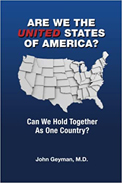
 |
Are We the United States of America? Can We Hold Together As One Country
by John Geyman, M.D.
Copernicus Healthcare
The author of this quote-filled, chart-filled, footnote-filled tome is a nonagenarian doctor. Being a senior of a certain age, he has seen and experienced an America pulling together as well as one being pulled apart. Within the pages of this book, author Geyman compiles his own thoughts, plus those of others, around the construct of community. What exactly is it? What are the forces that can disrupt a community and, by extension, threaten democracy? Also, what are some appropriate approaches to rebuild unity and a real sense of community in the USA?
Geyman begins his treatise appropriately with a look back at history. He touches base and comments on the country’s founding, the rise of agriculture and rural expansion, America’s Gilded Age, the Great Depression and FDR’s New Deal, prosperity and the rise of the middle class following the end of World War II, and Lyndon Johnson’s oversight of the reforms of the 1960s that came to be known as the Great Society. Geyman proposes that two major factors were responsible for serious cracks in the cement of the American community: the rise of corporate America and how it wound up becoming much more than it was ever meant to be and the neoliberalism movement that fostered “an economic ideology favoring free markets with little or no government regulation.”
From there, he turns a critical eye on troublemakers—those elements disordering community and menacing democracy itself. He systematically explores many things that play a role, such as changing demographics, the decline of the middle class, disparities and inequalities in race and income, corporate profiteering, consequences of the Citizens United Act, the impact of the COVID-19 pandemic, and more. He bemoans the rise of disinformation and how it adversely affects trust in government. Political polarization, mostly caused by extremism, is covered. And in extensive detail, he examines social media’s and, particularly, Facebook’s negative influences. The author writes: “Mark Zuckerberg, its originator and owner, bears responsibility for many of its flaws that divide people instead of bringing them together as he further enriches himself without regard for its adverse impacts.”
Like most good doctors, Geyman helpfully provides a prescription for curing the ills of a divided USA. He advocates a revitalization of traditional American values such as liberty, equality, diversity, justice and the rule of law, majority rule and representative government, truth, the common good, and the separation of powers brought about by the checks and balances of the Constitution. If that sounds like a prescription only of platitudes, be advised that he also bravely takes on some of the country’s hottest value issues—health care as a right, reproductive rights for women, a larger role of government in people’s lives, gerrymandering, the Senate filibuster, limits on corporate consolidation, updated antitrust laws, increased scrutiny of corporations, and, of course, taxes.
In addition to including the thoughts and opinions of others, as well as graphs and more to support his assertions, Geyman delivers his views in straightforward, non-Beltway-speak. He uses logical construction and relevant examples of what he believes and why he believes it in plain English that is easy to understand. Whether or not it’s easy to agree with will be up to the reader. Overall, Geyman has produced a comprehensive and thought-proking work that makes his opinion clear about a variety of subjects affecting American society.